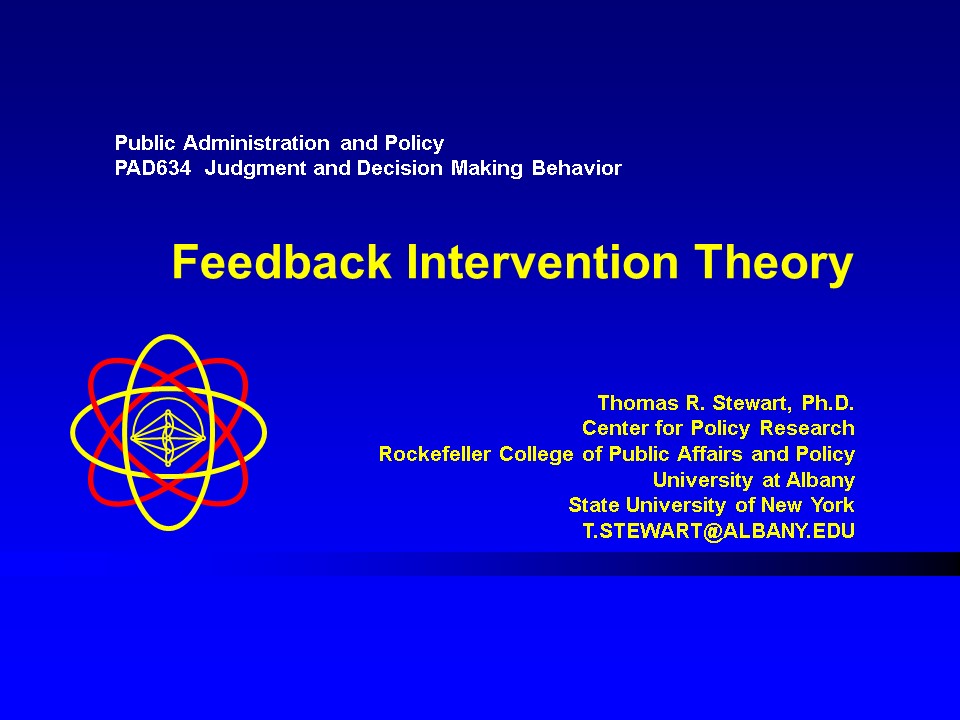Feedback Intervention Theory - PowerPoint PPT Presentation
Title:
Feedback Intervention Theory
Description:
Public Administration and Policy PAD634 Judgment and Decision Making Behavior Feedback Intervention Theory Thomas R. Stewart, Ph.D. Center for Policy Research – PowerPoint PPT presentation
Number of Views:353
Avg rating:3.0/5.0
Title: Feedback Intervention Theory
1
Feedback Intervention Theory
Public Administration and Policy PAD634 Judgment
and Decision Making Behavior
- Thomas R. Stewart, Ph.D.
- Center for Policy Research
- Rockefeller College of Public Affairs and Policy
- University at Albany
- State University of New York
- T.STEWART_at_ALBANY.EDU
2
Reference
- Kluger, A. N., DeNisi, A. (1998). Feedback
interventions Toward the understanding of a
double-edged sword. Current Directions in
Psychological Science, 7(3), 67-72.
3
Feedback intervention theory
Goal
Goal setting intervention
Discrepancy
Feedback intervention
Locus of attention
Performance
Task complexity
Task mastery
4
Discrepancy
- Both control theory and FIT claim that behavior
is regulated through the control of discrepancies
or errors in the system. When a self-regulating
system detects discrepancies or errors, the
system is motivated to reduce or lower the
perceived discrepancies. Even among competing
cognitive theories, the detection and evaluation
of feedback- standard (or feedback goal)
discrepancies is considered a fundamental source
for motivational processes.
Go to discrepancy and valence of feedback
Return to diagram
5
Discrepancy and valence of feedback
- Thus, we can offer an initial explanation for the
perplexing finding that the valence of feedback
does not have a simple moderating effect on FI
effectiveness. We suggest that it does not have a
simple effect because it activates two response
systems, one that responds to valence
symmetrically and one that responds
asymmetrically. The coexistence of two types of
responses to FIs hints that these processes may
have different effects on performance (e.g.,
pleasantness may enhance creativity, but arousal
may debilitate it). Understanding the role of
these systems in mediating the effects of FIs on
performance awaits more theoretical development
and empirical investigation. (p. 69)
Return to diagram
6
Locus of attention
- That is, after receiving feedback, an individual
is very likely to be thinking about something
different from what he or she was thinking about
before receiving the intervention. - We predicted that when FIs cause attention to be
directed to the self, the risk that FIs will
debilitate, rather than enhance, performance
increases (Kluger DeNisi, 1996). (p. 69)
Return to diagram
7
Task
- Resorting to a simple classification, we can,
however, consider task mastery (subjective
difficulty) and task complexity (objective
difficulty e.g., remembering 5 cues vs. 15
cues). From the perspective of control theory,
FIs that direct attention to the self on complex
tasks deplete the resources needed for task
performance and direct some of these resources to
self-related goals (e.g., self-enhancement). In
contrast, FIs that direct attention to the self
on simple tasks may augment performance in a
manner similar to social facilitation effects.
(Social facilitation effects are the effects of
the presence of other people on performance
Performance of subjectively simple tasks is
facilitated, and performance of subjectively
complex tasks is hindered.) (p. 71)
Return to diagram
8
Practical Implications
- FIs. One clear answer lies in using FIs only in
combination with goal-setting intervention. - It seems that providing FIs without clear goals
increases the risk that the recipients goals
will not be those intended by the FI provider.
(p. 71)































